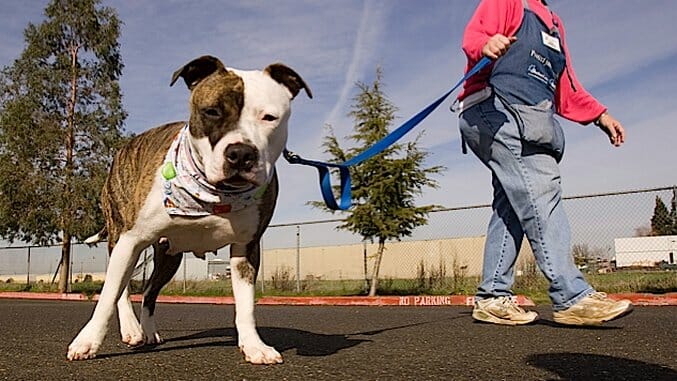It’s Time to End Breed-Specific Legislation Like the Montreal Pit Bull Ban
Photo by David Paul Morris/Getty
A few weeks ago The New York Times published an unnerving story about Diggy, a dog in Michigan whose crazed smile had gone viral. The widely shared photo of Diggy and owner Dan Tillery had caught the eyes and ire of local police. They contacted Mr. Tillery demanding proof that Diggy wasn’t a pit bull, a breed Waterford Township bans. If Diggy was even part-pit, he would have to return to the Detroit Dog Rescue.
Now in Montreal, police await DNA results for a dog that mauled a woman, Christiane Vadnais, to death in June. The dog was registered as a boxer, but that didn’t stop myopic Mayor Denis Coderre and 37 councilmembers from panic-voting on September 27 to ban pit bulls in the city.
Contrary to what Montreal, Waterford Township, and countless other places would have us believe, we cannot glean a dog’s goodness or wickedness from its breed.
We don’t need a DNA test to tell us that a dog who mauls a woman to death is bad. (Though he probably wasn’t born that way: the dog’s owner named him Lucifer, and one shudders to think how he treated him.) Likewise, we don’t need to know Diggy’s breed to know that he is good. We know Diggy is good and Lucifer is bad the same way we know how people are good and bad—from their actions.
Not that it should matter, but Diggy is an American bulldog. He can stay.
I recently came across a cartoon in which a pack of Salem pilgrims force a dog off a plank into a tank of water, saying, “If he floats, he’s a pit bull!” Idiot humans have demonized many breeds over the years—German shepherds, Dobermans, Rottweilers, mastiffs—but no dog has been so victimized and vilified as the pit bull. (The jaw-locking thing is a myth, by the way, one that’s been linked to those other breeds as well.)
We chop off their ears, choke them, breed them, torture them, and force them to fight—and then we oppress and execute pit bulls for their inherent cruelty.
![]()
The pit bull is not an official breed; it’s a catchall term for American pit bull terriers, American Staffordshire terriers, Staffordshire bull terriers, and/or any strong dog with a blocky head, short hair, and a wide smile. That is one of the many, many problems with breed-specific legislation (BSL): as exemplified in Waterford Township, pit bulls are misidentified as often as they are identified. You can’t determine breed via eye test, only DNA test.
A 2015 study in The Veterinary Journal found, “Whereas DNA breed signatures identified only 25 dogs (21%) as pit bull-type, shelter staff collectively identified 62 (52%) dogs as pit bull-type.” (So no, René Cadieux, pit bulls are not like pornography.)
More importantly, there is no evidence that BSL reduces dog bites. It’s expensive and ineffective, so much so that the American Veterinary Medical Association, the American Bar Association, the Centers for Disease Control and Prevention, the Obama administration, the Canadian branch of the Humane Society International, and even an independent advisory group appointed by the Quebec government all oppose BSL. (PETA remains a joke.)
-

-

-

-

-

-

-

-

-

-

-

-

-

-

-

-

-

-

-

-

-

-

-

-

-

-

-

-

-

-

-

-

-

-

-

-

-

-

-

-








































